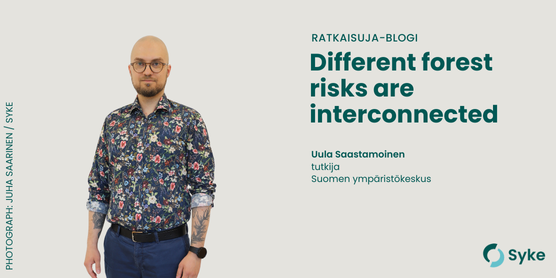
Climate change has many unpredictable impacts on Finland's forests. Preparing for the increasing frequency of forest disturbances poses challenges for governance. In the recently concluded EIFFEL project’s Finnish pilot, we developed an impact assessment framework suitable for examining multi-hazard risks in forests. As part of this risk framework, we produced new drought forecast maps and modeled the presence of seven moth species that cause forest damage, as well as changes in forest fire risk. The aim has been to consider the interconnectedness of risks, meaning that risks can occur either simultaneously or as a consequence of one another, where the combined impact can be greater than the impact of a single risk.
Preparing for and adapting to the impacts of climate change requires effective cross-sectoral cooperation
Both research and practical efforts recognise the interconnectedness of different risks. In a broader context, the need for joint, anticipatory, and comprehensive risk management has been identified, and various sectors have produced their own adaptation plans. From a governance perspective, it is essential that the interconnectedness of risks would also considered in national-level plans.
Regarding forest risks, coordinated management among different actors can be challenging even within a single risk. Therefore, it would be important to clarify the roles and responsibilities among various stakeholders to improve coordination. As an ambitious long-term goal for achieving sustainability transformation, strengthening institutional frameworks related to multi-hazards should be part of broader climate change adaptation management. National, regional, and local actors should have the capacity to anticipate and respond to risks.
Research knowledge will continue to play a key role in the planning of adaptation and preparedness, and thus it would be beneficial to promote information sharing among different actors to increase impact, while considering constraints. Broad integration of information provides a more comprehensive overall picture, helps in creating more accurate models as well as developing policy measures.
Aiming for more effective cross-sectoral cooperation
Achieving sustainability transformation requires developing governance that cuts across sectors and scales. Transforming governance requires resources and steering from the state-level, in addition to the guidance already coming from the international level. Realistically, implementing new practices within an organisation may require additional project funding. On the other hand, information exchange between different organisations might simply require identifying the right people and opening communication channels between them. It is therefore crucial to find ways to consider risk interconnectedness also within existing practices.
It is important to remember that phenomena like forest fires and pests are a natural part of forest ecosystems. Forests are subject to various objectives, and in a broader context, adaptation as part of sustainability transformation means much more than merely anticipating and minimising forest damages. Informational guidance in the form of instructions and training for various forestry stakeholders and forest owners is therefore also essential for turning knowledge related to multi-hazards into practical action. This way, stakeholders have the most up-to-date information on the interconnectedness of risks to support decision-making related to the use of natural resources.
Uula Saastamoinen is a researcher at Syke’s built environment solutions unit and a doctoral researcher at the University of Helsinki. As part of their work and PhD they research the impacts of sustainability transition on land use and environmental governance. Outside work they can be found meditating in a forest.
More information about the EIFFEL project
Opinions of blog contributors do not necessarily reflect the official views and opinions of the Finnish Environment Institute.